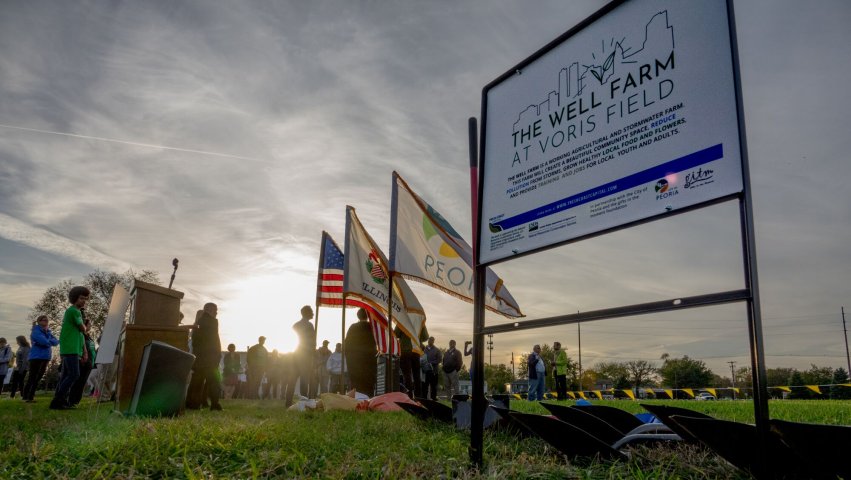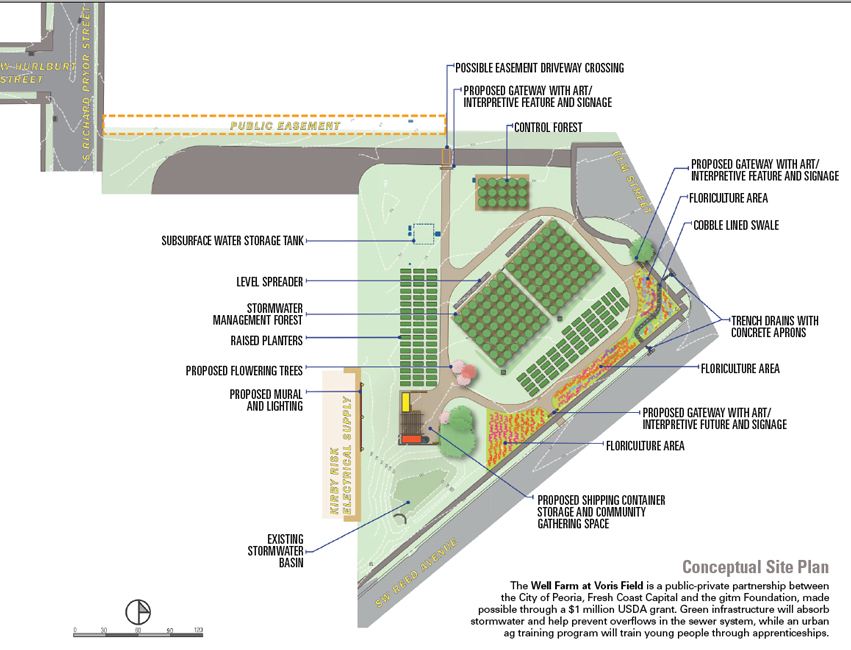
With a new urban farm, farmer’s market and educational efforts, the gitm Foundation is helping to bring urban agriculture to Peoria.
Ten years ago, a friend of mine, Denise Urycki, and I found ourselves building a community-based garden over by Logan Recreation Center in Peoria’s South Village. Countless hours of volunteer time later, the garden was producing hundreds of pounds of great, locally grown vegetables and fruit, which was then given away at our own urban farmer’s market held in the Neighborhood House parking lot.
While this food was helping the families who lived within walking distance of the farmer’s market, there was so much left to do. Over the following five years and counting, we have been sounding the alarm for greater collaboration in our efforts to improve the local food system.
Denise and I—or “the gitm gals,” as some like to refer to us—hope that residents throughout the Greater Peoria region can begin to see through a different set of eyes… a set of eyes that have worked diligently to help the most vulnerable of families find healthier food options. Our hope is to share in the gift of these new visions.
Vision: Merging Economic Development With Improved Healthy Food Access
While much of Peoria’s exciting growth is coming from the revitalization of the city’s Warehouse District, huge potential exists in marrying strong economic development to community health needs. By contributing to solutions for issues like food insecurity and nutrition, urban agriculture can provide a range of environmental, social and economic benefits.
Urban agriculture, according to the USDA, can take “the form of backyard, rooftop and balcony gardening, community gardening in vacant lots and parks, roadside urban fringe agriculture and livestock grazing in open space.” The new Urban Agriculture Apprenticeship Program—in which residents learn basic agricultural skills, business planning and marketing of agricultural products—is a cornerstone of these efforts in Peoria. The first cohort began in February, with classes being held at the Peoria Public Library’s Lincoln Branch. Eventually, plans call for a permanent home for these efforts: the creation of a South Peoria Food Hub and Educational Center.
A new urban farmer’s market will allow local families to purchase produce grown by the apprentices at urban farm sites such as The Well Farm, South Garden and Learning Center, and other lots throughout south Peoria. A partnership between this new market and Tianguis, the Hispanic market located at the corner of Pecan and Adams streets, will help to create a destination marketplace, producing cross-marketing and event opportunities in order to attract more people to the area.
Vision: Connecting the Energy of the Warehouse District with the Needs of the South Village
Local dollars build greater local wealth. To give rise to viable markets for local growers, there needs to be a greater variety of buyers coming from all over the city and region.
The recent loss of Kroger’s grocery stores has taught our community a few hard lessons. One of the more pressing lessons is that replacing one grocery store with another may help in the short term—but how do you get continuous buyers in the door so businesses can profit, and therefore, stay? Drawing people from all over the city can help sustain the market as a destination.
Future plans for the educational center include value-added product production and branding, as well as a teaching/educational kitchen where residents can learn how to produce safe products, healthcare groups can hold nutrition and cooking education classes, and space can be rented for other small businesses to use.
It is of upmost importance to see that all the talent and resources we need are here today: right here, right now. Residents who become involved in urban agriculture can feel empowered by the possibility of working constructively and collaboratively, together, and building their community—in addition to producing food and other products for sale and consumption.
Vision: Resisting the Urge to Stall in Planning—Start Small, Be Intentional and Then Go!
We “gitm gals” caution against local development waiting for the fatted calf to be the salvation to the burden of joblessness. While the tendency exists to hope for a large employer to swoop in and hire hundreds of residents, we believe organic efforts to create industry can be more effective. Increasing access to healthy food options while building a strong workforce requires many hours of planning. But once a plan is in place, we need to take steps to move toward action. The gitm gals are planners, but better yet, we are doers.
Urban agriculture can provide employment opportunities and environmental improvements, while enhancing food security. According to the RUAF Foundation, it “contributes to local economic development, poverty alleviation and social inclusion of the urban poor and women in particular, as well as to the greening of the city and the productive reuse of urban wastes.”
Besides growing, selling and marketing locally-grown products, numerous other jobs are in the waiting for residents interested in urban agriculture. Cities that have ventured into its fullest potential have seen an increased need for growers, food producers, land developers and designers, chefs, wholesale sellers and vendors, as well as jobs in transportation and distribution, waste and recycling management, community development, parks and recreation management, healthcare, retail services and restaurant management… just to name a few. iBi


